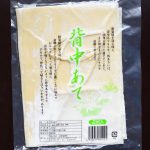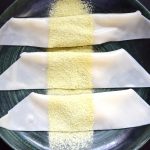Obon is a four-day holiday that takes place every year in mid-August (in most places), and is a celebration that marks the return of the spirits of the deceased to the human realm. Different regions and some cities have unique customs for the holiday, but almost all share the custom of people returning to their hometowns, cleaning their ancestor’s graves, and dancing some sort of bon-odori (or Obon dance).
In the Hachinohe Area, specifically concentrated around the area of Hachinohe City itself, there is a unique custom not found anywhere else in Japan: offering senaka-ate at the family altar on the last day of Obon. Senaka-ate is a type of food that is sheets of dough made with, true to the non-rice-based-culture of Hachinohe, wheat flour. Translating the name senaka-ate from Japanese to English results in ‘back pad’ or ‘backrest’, and this gives some indication to the meaning and function behind this custom.

During the Obon period, when the spirits of deceased ancestors are said to be visiting, the living family members make offerings of food, flowers, etc., at household altars that many houses have in Japan. Concerned that all of these gifts would be a burden for their ancestors to carry during their return to their dwelling place, the people of Hachinohe offer these sheets of dough known as senaka-ate to act as back pads for their ancestors, so that their presents don’t feel so heavy. True to the utility of the food, each pack of dough sheets includes thin little strips of dough on the side, strings for the ancestors to tie their luggage together.
After being offered to the ancestors first, senaka-ate is then usually prepared as a dessert by boiling the dough and dusting it with kinako (roasted soybean powder). People who don’t use senaka-ate for Obon offerings also buy it just to eat, as thanks to its neutral nature it can be served with almost any topping, both sweet and savory, and it is a delicious seasonal treat. It can be found in most local supermarkets, but as it is only sold during the Obon season, make sure you snatch up this regional dish before it disappears.

